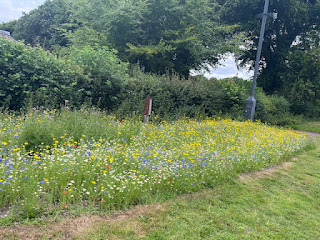Monday, 7 July 2025
Balsam bashing and fencing at Styal on Sunday 6th July 2025
Sunday, 6 July 2025
Balsam. bashing at Dunham Massey on Sunday 29th June 2025
Eight of us from MNTV (including a new volunteer) met with Ranger Jon and four Merseyside volunteers on this warm and humid Sunday, to "bash" as much Himalayan balsam as possible before it burst its seed heads and spread further around the wooded area beyond the overflow carpark.
Ranger Jon wasn’t particularly concerned about us tidily piling up the balsam once we’d pulled it up and snapped the lowest node of the stalk off to make it difficult to re-root. He was more focussed on us pulling up as much as possible so the balsam didn’t have the chance to spread its seeds into the Park.
In smallish groups we went into the wood and found patches of balsam to destroy - which was a very satisfying feeling. After our morning coffee break we continued the task, moving further into the wood. By lunchtime we were getting tired and were feeling a lot warmer than when we started. Most of us were in long sleeves to try and protect our arms from the brambles and nettles and some had caps on too to stop the midges and twigs from trees getting tangled with our hair.
Sunday, 22 June 2025
Balsam pulling at Speke Hall - Sunday 22nd June 2025
It was a small turnout for our return visit to Speke Hall on 22nd June... just three volunteers.
We were again working in Stockton Wood but this time we were working right at the back of the woods next to the tyre factory. The task was balsam pulling but with hardly any balsam it was more like weeding the woods!
Due to the balsam being spread out across the woods we could not really get a before and after picture.
As you can see below the wood is very dense with prickly bushes which made the task quite difficult at times.
The balsam was mostly quite small but we did occasionally find a larger plant!
Monday, 16 June 2025
Cutting down poplar saplings at Formby on Sunday 15th June 2025
Six of us met Ranger Al in the Lifeboat Road carpark. The forecast said cloudy but there wasn’t a cloud in sight so we slapped on the sun cream just in case it stayed like that.
We drove from the public carpark to get closer to the worksite which was on land south of Lifeboat Road recently given to the NT to manage by Sefton Council. We went through an automatic gate into a very exclusive housing estate with a very large new manor house which would rival several NT stately homes!
The task was chopping down White and Grey Poplar saplings to reduce the vegetation in the area and allow for more sand dunes. The saplings spread along root systems, so are clones:
They plan to have contractors in to take out the big trees ...
... but the smaller trees will grow rapidly when the larger tress are removed, so needed to be nipped in the bud.
Al explained that Formby has about 10% of the country's entire population of Black Poplar, which we were leaving alone. They have done genetic testing and the 800 mature black poplar trees in Formby are all clones from just two trees! The black poplar is an endangered species and most of the trees are male.
During the day we had a walk over to “Devils hole”, an area of shifting sand dunes deep enough to have a pond at the bottom – although it has been so dry recently there wasn’t much water in it.
Ariel view when there was more water about:
We slowly worked our way around a patch of established woodland cutting down the smaller poplars and stacking the brash in the trailer. The brash will get used for dead hedging to make a stockproof fence to help control the longhorn cattle they hope to have grazing on the land in the winter.
The day continued warm, but with an onshore breeze it wasn’t too bad. We managed to clear a long strip beside the wood, but there is still plenty of work left for the local group to do cutting the rest of the poplars down.
Jenny
-
Monday, 9 June 2025
Putting in fence posts at Styal on Sunday 8th June 2025
Monday, 2 June 2025
Staking out the dahlias at Biddulph Grange Gardens on Sunday 1st June 2025
We had to put a line across between the stakes measure the gap divide the gap by the number of SPACES required in the map. Then place the stakes equal distance apart. It turns out that despite my maths degree, arithmetic is harder than it looks. But we did get the hang of it eventually. The stakes were hammered in to make a solid support for the Dahlias.






















